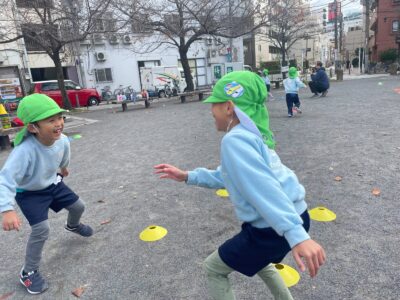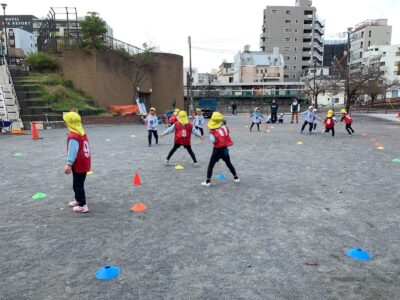Dec 2, Coordisports P.E. Report
Mr Shuhei comes to CGK Preschool every two weeks to lead his super fun PE lessons.
Each column will feature some insights or stories about physical development, reports for each PE lesson, and share some YouTube videos showing some physical activities that you can try at home with your child.
-
Expert Column
I mentioned that there are two types of reactions: simple reaction and selective reaction. To review, simple reaction is how quickly you can react. Selective reaction is the ability to react accurately and quickly to cues. In this column, we will consider which of these are required in different sport. Depending on the sport, open skills and closed skills are required. Open skills are those that are influenced by external factors. Examples of such sports are soccer, basketball, and kendo. These sports require selective reaction skills because the direction, strength, and timing of your reaction changes depending on what your opponent does. You need to judge where your opponent will place their penalty kick in soccer or position for a rebound in basketball based on the arc of the shot. Closed skills, on the other hand, are skills that are not affected by external factors such as track and field, gymnastics, and skipping. These sports require simple reaction skills because the cues one needs to be aware of aren't as constant or varied. These include the starting signal to a race, and the adjusting into a figure-eight jump of a long rope. If both reaction skills are developed in early childhood in a fun way, then they can be smoothly transitioned to specialized sports.
-
Jungle (3-year-old) Class Lesson Report

[Safety Zones are Important]
It was a cold morning, but we had PE in the park and warmed up with lots of running. This time, we did (1) mini cones jumping (2) mini cones maneuvering , and (3) island crossing tag. Last time, we did tag, where if you get tagged you are out, and, if you get tagged you become the demon, and ice tag. This time, we wanted to try Kawari Oni where the tagged child takes over as the demon. But due to the construction work at the park, the available area was too limited and we had to give up the idea. Instead, we played Island Crossing Tag instead. An area of 1.5 square metres was created with mini cones and used as an island. The islands act as a safe zone for the children because the demons cannot enter it. When the children leave an island and move to another one, the demon can then tag them. The children observed the demon's movements carefully and moved to another island when the demon was not there. Three-year-olds may find it difficult to simultaneously monitor the demon's movements, the movements of their friends, and maneuvering to another island. By creating an island, a safe zone where they cannot be tagged, they can check the demon's location and challenge themselves to move to another island. Just as a child needs a safe environment in order to try new things, having the islands allows them to take on the next challenge. We would like to continue to make PE time a safe place where the children can truly enjoy ourselves.
*No Video for this time -
Mountain (4-year-old) Class Lesson Report

[Keeping Score]
It suddenly got cold in December. Once again, PE was held in the park, and the children ran around in the cold. We did the following three activities: (1) mini cones jumping, (2) island crossing, and (3) island-crossing tag game. As a warm-up, the children jumped over different mini cones with both feet. The key is to jump over the mini cones with both feet together. Jumping over with both feet is the same as jumping over a vaulting box. If the children can do this movement, they are able to raise their hips higher on the vaulting board and spread their legs wider for the jump and improve other jumping techniques. In fact, all the movements are connected. The island-crossing tag game in a 1.5 square meter area. Inside, islands were made with mini cones. Inside these islands, the demon cannot tag the children. If the children can move successfully from island to island, they will get one point. But if they leave the island, they risk getting tagged by the demon. The children need to be aware of where the demons are so they can successfully maneuver between islands and score points. At the end, the points were calculated. The children shared their points. During the game, it is hard to keep track of the points. So the responsibility is placed on the children to keep track of their own points. But the children may have miscalculated, forgotten, or just did some cheeky calculating when they shared their points. And it is quite possible that correctly calculated their points. So the points will vary from child to child. But for now, it is more important for the children to experience keeping count by themselves rather than being sure that they are correct. We will continue to do activities where they need to keep count of their own points.[Video]Cones jumping leads to jumping over a vaulting box
-
Sky (5-year-old) Class Lesson Report

[Strategising and Role Assignment]
Although it suddenly became cold in December, the children enthusiastically had PE in the park. We played 1) square tag and 2) sports tag. In square tag, the children first played tag by running around the outside of a 1.5 square metre area. No one is allowed to enter the square and no one is allowed to go far from the square. If the children can turn quickly in the opposite direction, then they can tag the child that they are chasing. Next the rules changed a bit: the children avoid being tagged by the demon who is reaching in from the outside of the square. The children had to time their movements based on the movement of the demon. You can watch the video below to get an idea on how the game is played. Then, continuing from the previous activity, we played a team tag game. The red and white had to try and capture the cone at the opposing side's team whilst avoiding being tagged. Since the game had been conducted in the previous PE lesson, the teams were better at assigning attacking and defending roles.. At first, the white team had the advantage, but after a team meeting, the red team turned the tables! The sudden team meeting to change the strategy had worked! Being able to communicate is a strong skill for older children. We will continue to incorporate this into our PE lessons in the future.[Video]Summary of two types of Shikaku tag games
coordisports Inc.
Shuhei Otsuka
coordisports
■Books
動画でわかる! 小学校体育 コーディネーション運動50 (体育科授業サポートBOOKS)
1年間まるっとおまかせ! 小学1・2年担任のための学級あそび大事典 (共著)
1年間まるっとおまかせ! 小学3・4年担任のための学級あそび大事典 (共著)
1年間まるっとおまかせ! 小学5・6年担任のための学級あそび大事典 (共著)






















